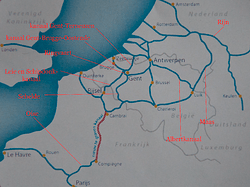Seine–Nord Europe Canal
| Seine-Nord Europe Canal | |
|---|---|
|
Location of the Seine-Nord Europe Canal in northern France. | |
| Specifications | |
| Length | 107 km |
| Lock length | 195 m (640 ft) |
| Lock width | 12.50 m (41.0 ft) |
| Maximum boat length | 185 m (607 ft) (push-tug + 2 barges) |
| Maximum boat beam | 11.40 m (37.4 ft) |
| Minimum boat draft | 3.50 m (11.5 ft) |
| Locks | 6 (originally 7) |
| Total rise | 53.60 m (175.9 ft) |
| Status | Preparation for tender |
| History | |
| Date approved | 2009 |
| Expected completion | 2024 |
| Geography | |
| Start point | Oise River at Compiègne |
| End point | Liaison Dunkerque-Escaut Aubencheu-au-Bac |
| Connects to | River Oise |
The Seine-Nord Europe Canal is a projected high-capacity (grand gabarit) canal in France that would link the Oise River at Compiègne with the Canal Dunkerque-Escaut, east of Arleux. The objective is to expand trade flows in a fuel-efficient and ecologically friendly manner between the Seine basin and Belgium, Germany and the Netherlands, while reducing saturation on the A1 motorway in France and reducing the CO2 emissions in the transport sector within this corridor.
The canal will be the French section of the Seine-Escaut (Scheldt) European waterway, which includes further major investments on the Canal Dunkerque-Escaut, on the Lys/Leie in Flanders and on the waterways in Wallonia. It will run 107 km from just north of Compiègne, to the Canal Dunkerque-Escaut, crossing the regions of Picardy and Nord-Pas-de-Calais.
The 107-kilometre-long canal will connect the Seine and Scheldt rivers and facilitate inland water transport. When the new Seine-Nord connection is ready, it will allow large vessels to transport goods between the Seine river (and the Paris area) and the ports of Dunkerque, Antwerp, and Rotterdam, or further into Europe. The canal will replace the Canal de Saint-Quentin and the current Canal du Nord, increasing maximum barge capacity from 650 to 4400 tonnes.[1]
The canal will include several large structures, including six locks and three aqueducts: two over the A29 and A26 motorways, and one 1330 metres long over the Somme.[2] The project’s budget will be €4.7 billion, financed by the European Union, the French government, the Hauts-de-France and Île-de-France regions and the départements Oise, Somme, Pas-de-Calais and Nord.
The project was called into question after a change of Government in July 2012, not per se but for its cost and the principle of a public-private partnership (PPP) which after the financial crisis of 2007-2008 was found to be unworkable. Significant cost reductions were deemed possible, and 'reconfiguration' of the project led to use of the line of the existing Canal du Nord over a length of about 8 km (5 mi), lowering the summit level by 18.50 metres and thus eliminating one lock. Engineers were selected for the project in June 2015.[3]
On 21 April 2016, an ordonnance was approved by the President of France, authorizing the construction of the canal and creating the Société du Canal Seine-Nord Europe to manage the project.[4]
Economic impact
The existing Canal du Nord and parallel Canal de Saint-Quentin represent a bottleneck on one of Europe’s principal transport arteries. This is reflected in the current statistics: where the market share of inland water transport measured in tonne-kilometres reaches 18% in the Seine-Oise basin and 14% in Nord-Pas de Calais, and even more than 50% on the major waterways of Germany and Benelux, the constraints of carrying capacity on the corridor in France limit the waterway market share to between 3 and 4% (peaking at about 5 million tonnes).[5] Traffic is projected to reach between 15 and 18 million tonnes per year a few years after the waterway has opened.
Environmental impact
Voies Navigables de France, the project authority, sets out the principal environmental impacts on the website dedicated to the project. The CO2 emissions of a barge carrying 1500 tonnes are three times less than those of the fleet of trucks required to move this load. A single push-tow 185 m long can carry 300 containers unloaded in a maritime port, compared to 5 fully loaded trains and 200 trucks.

References
- ↑ VNF, 'The canal Seine-Nord Europe project planning regional, national and European'
- ↑ VNF, Canal and related facilities
- ↑ "107 kilometer kanaal verbindt Frans en Nederlands waternetwerk". Verkeerskunde (in Dutch). 25 June 2015.
- ↑ "Ordonnance n° 2016-489 du 21 avril 2016 relative à la Société du Canal Seine-Nord Europe (NOR: DEVT1605203R)". Legifrance. 21 April 2016.
- ↑ Edwards-May, David (2010). Inland Waterways of France. St Ives, Cambs., UK: Imray. p. 281. ISBN 978-1-846230-14-1.
External links
- Official project website setting out the objectives and governance of the project, the players involved and the programme of works
- Seine-Nord Europe Canal - a preview with maps and details of places, ports and services and the extensive and robust water supply system (by the author of Inland Waterways of France, Imray)
- Navigation details for 80 French rivers and canals (French waterways website section)
